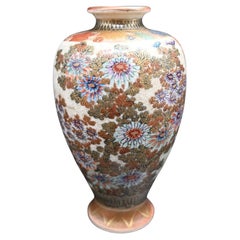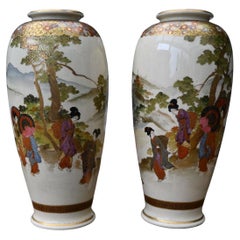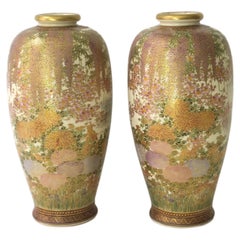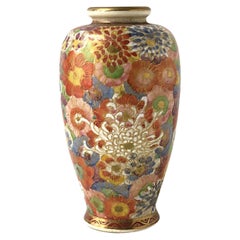Satsuma Furniture
to
2
2
2
2
2
2
2
2
2
2
2
2
4
2
2
2
1
Creator: Satsuma
Dealer: Art Classique
High Quality Old Japanese Satsuma Earthenware Vase, ca 1900, Meiji period
By Satsuma
Located in Bilzen, BE
A rare antique handpainted Japanese Satsuma earthenware vase, signed
Fine quality
Good overall condition, no chips, cracks or restorations
Height 14 cm
Category
Early 20th Century Japanese Meiji Satsuma Furniture
Materials
Earthenware
Pair Of Satsuma Earthenware Vases "zenkozan" Japan, Meiji Period
By Satsuma
Located in Bilzen, BE
Pair of Earthenware vases from Satsuma Japan
Each side with different decoration
Signature under the base "Zenkozan" end of the Meiji period
Height 22 cm
Perfect condition
Category
Early 20th Century Japanese Meiji Satsuma Furniture
Materials
Earthenware
Related Items
Japanese Satsuma Vases, Pair
By Satsuma
Located in New York, NY
A gorgeous pair of Japanese earthenware Satsuma vases, hand-painted, Meiji period, circa early-20th century, Japan. Vases' beautiful decoration is high-quality, hand-painted, and ext...
Category
Early 20th Century Japanese Meiji Satsuma Furniture
Materials
Earthenware
Japanese Satsuma Vase
By Satsuma
Located in New York, NY
A gorgeous hand-painted Japanese Satsuma vase, Meigi, circa 20th century, Japan. Beautiful hand-painted detail of colorful flowers and spider mum flowers around finished with gold de...
Category
20th Century Japanese Meiji Satsuma Furniture
Materials
Earthenware
Antique Meiji Period Japanese Satsuma Vase Floral Decoration, 19th Century
Located in Amsterdam, Noord Holland
Fabulous Japanese earthenware Satsuma Vase with nice decoration of flowers. Meiji period, 19/20th c
Lovely piece.
Additional information:
Material: Porcelain & Pottery
Japanese Sty...
Category
19th Century Japanese Meiji Antique Satsuma Furniture
Materials
Porcelain
Satsuma Japanese Meiji Pair Diamond Shaped Pottery Vases
By Satsuma
Located in Bishop's Stortford, Hertfordshire
A good and unusual pair antique Japanese Satsuma Meiji diamond shaped pottery vases decorated with monk figures with a scrolling dragon dating from the 1...
Category
19th Century Japanese Meiji Antique Satsuma Furniture
Materials
Pottery
Large Pair of Meiji Period Satsuma Vases
Located in Brighton, Sussex
A very impressive and decorative pair of 19th century (Meiji period 1868-1912) Japanese Satsuma flared neck vases. Each with wonderful gilded and hand-painted decoration. Depicting out door scenes of people on horse...
Category
Late 19th Century Japanese Antique Satsuma Furniture
Materials
Porcelain
A finely-decorated Satsuma earthenware Vase, gold gilt, hand-painted, 18/1900s
By Satsuma
Located in Skien, NO
A Japanese antique vase - finely-decorated / hand-painted Satsuma earthenware vase from ca. Meiji era (1868-1912) or late 19th/early 20th century, depicting temples amongst fjell and...
Category
Early 20th Century Japanese Satsuma Furniture
Materials
Earthenware, Stoneware
Antique Japanese Meiji Period (1868-1912) Satsuma Vase by Kinkozan
By Kinkozan
Located in Newark, England
Signed Kinkozan 金光山
From our Japanese collection, we are delighted to offer this Japanese Satsuma Vase by Kinkozan. The vase is potted in globular form with a tightly pinched neck and rolled top rim beautifully decorated with four highly detailed individual panelled scenes. The first a Geisha baring a gilt basket with her child playing with a fan infant of a gilt fence encompassing blossoming foliage and bamboo plants. The second scene depicts two birds, a Red Headed Japanese Wood Pigeon and a white dove in the foreground with a similar gilt fence with blossoming kiku flowers (chrysanthemums). The third scene is painted as a bustling village community with multiple figures going about their daily jobs, a central Palanquins can be seen with two figures carrying a seating figure. To the background a mountainous river landscape can viewed bordering the top left corner. The final scene appears similar to the opposing one with birds swooping high above a polychrome Japanese...
Category
Late 19th Century Japanese Meiji Antique Satsuma Furniture
Materials
Ceramic, Earthenware, Pottery
Small Antique Meiji Period Japanese Satsuma Vase with Mark
Located in Amsterdam, Noord Holland
Fabulous and small japanese earthenware Satsuma vase of great shape and scene.
Marked: Cannot decipher.
Additional information:
Material: Porcelain & Pottery
Type: Vase
Region of O...
Category
19th Century Japanese Antique Satsuma Furniture
Materials
Porcelain
High Quality Japanese Meiji Cloisonne Enamel Vases
Located in New York, NY
A pair of high quality symmetrical Japanese, Meiji era, enamel over brass vases. Each vase has an amphora shaped body and a short wide neck. Each ware is enameled with polychrome pan...
Category
Early 20th Century Japanese Meiji Satsuma Furniture
Materials
Brass, Enamel
Pair of Antique Meiji Period Japanese Satsuma Vases Figural Decoration Marked
Located in Amsterdam, Noord Holland
Fabulous Japanese earthenware Satsuma Vase with nice decoration of flowers and figures decoration marked. Meiji period, 19th c
Lovely piece.
Marked base, both faded.
Additional in...
Category
19th Century Japanese Antique Satsuma Furniture
Materials
Porcelain
An Exquisite Quality Meiji Period Japanese Cloisonne Enamel Bud Vase
Located in New York, NY
Presenting a truly remarkable piece, this large exquisite quality cobalt ground Meiji Period Japanese cloisonne Enamel Bud Vase. This magnificent artwork embodies the timeless beauty...
Category
19th Century Japanese Meiji Antique Satsuma Furniture
Materials
Enamel
Meiji Period High Relief Porcelain Celadon Vase, circa 1900
Located in Miami, FL
This captivating Meiji period (1868-1912) porcelain vase features a mesmerizing celadon glaze, with a subtle crackled texture. Exquisite details, meticulously hand-painted in vibrant...
Category
Early 20th Century Japanese Meiji Satsuma Furniture
Materials
Porcelain
Satsuma furniture for sale on 1stDibs.
Satsuma furniture are available for sale on 1stDibs. These distinctive items are frequently made of ceramic and are designed with extraordinary care. There are many options to choose from in our collection of Satsuma furniture, although brown editions of this piece are particularly popular. Many of the original furniture by Satsuma were created in the neoclassical style in east asia during the 19th century. If you’re looking for additional options, many customers also consider furniture by Imari Porcelain, Ando Jubei, and Kinkozan. Prices for Satsuma furniture can differ depending upon size, time period and other attributes — on 1stDibs, these items begin at $382 and can go as high as $16,800, while a piece like these, on average, fetch $2,300.
Creators Similar to Satsuma
Questions About Satsuma Furniture
- 1stDibs ExpertApril 5, 2022Satsuma porcelain or pottery includes a maker’s mark with the name of the person who made the item. Japanese numbers may also indicate that a Satsuma piece was part of a collection. Genuine Satsuma pieces will not have a “Made in Japan” label and should only include Japanese characters. When in doubt, work with a certified appraiser to determine the authenticity of your Satsuma piece. Find a variety of expertly vetted Satsuma porcelain and pottery collectibles on 1stDibs.
- Is Satsuma pottery valuable?1 Answer1stDibs ExpertApril 26, 2024Yes, some Satsuma pottery is valuable. The age, type, style and condition will determine how much a particular piece is worth. In addition, the history of ownership may also make a piece more valuable. For example, if a piece was previously in the collection of a notable person, such as a member of the Japanese Imperial Family, it may be worth more. To get an estimated value for a particular piece, consult a certified appraiser or knowledgeable antiques dealer. Find a range of Satsuma pottery on 1stDibs.
- 1stDibs ExpertOctober 7, 2024The difference between Satsuma and moriage is that the former is a type of pottery, and the latter is a technique for decorating pottery. Satsuma pottery is the term for earthenware pottery from Japan's Satsuma region. Although there are different styles, the most common element of Satsuma pottery is a heavy, dark glaze. Moriage is the term for when potters add raised slip decorations to pottery, creating a three-dimensional effect. Some Satsuma pieces show off moriage details, while others do not. Shop a range of Satsuma pottery on 1stDibs.
- How do I date a Satsuma vase?1 Answer1stDibs ExpertMarch 22, 2022To date a Satsuma vase, study its mark. Vases made before World War II normally feature a mark in Japanese. A vase that says "Royal Satsuma" likely dates back to the late 20th century. You'll find a variety of expertly vetted Satsuma vases on 1stDibs.
- What is a Japanese Satsuma vase?1 Answer1stDibs ExpertOctober 12, 2021A type of Japanese pottery originated from Satsuma province in Japan is termed as Satsuma ware. A vase of this kind is known as a Satsuma vase. An interesting fact about Satsuma ware is that they feature a "makers mark" or marking as a key to help collectors unlock the value, age and authenticity of the piece. Shop a range of antique and vintage Japanese vases on 1stDibs.
- 1stDibs ExpertNovember 4, 2024To identify Satsuma pottery marks, you'll typically need to perform research using trusted online resources. Satsuma is a region in Japan known for its pottery, and many factories and artisans have operated there, including Kinkozan, Taizan, Yasuda, Choshuzan, Fuzan, Gyozan, Koshida and Maruni Kobe. Each maker has its own marks associated with it, and these typically are in Japanese kanji characters. You can compare the characters on your piece to pictures shared online to find a match. Alternatively, a certified appraiser or experienced antique dealer can help you identify your pottery markings. On 1stDibs, shop a selection of Satsuma pottery.
- 1stDibs ExpertFebruary 1, 2024One way to tell if your Satsuma vase is valuable is to look for markings on it. The oldest and typically most expensive pieces will usually have the Shimazu family crest — a circle with a cross through it — hand-painted on the bottom. If the piece is stamped with the marking or says "Made in Japan" in the Roman alphabet, it is a newer vase. Factors like the style of the vase and its condition will also impact its price. It's a good idea to have a certified appraiser or knowledgeable dealer evaluate your vase to determine its value. Find a variety of Satsuma vases on 1stDibs.
- 1stDibs ExpertSeptember 9, 2024Yes, some Satsuma pottery is worth something. Depending on their age, maker, type, style, condition and other factors, pieces may sell for a few hundred to several thousand dollars. Looking at sales and auction histories can give you a rough idea of the value of a piece. For a more definitive valuation, use the services of a certified appraiser or knowledgeable antique dealer. On 1stDibs, explore a collection of Satsuma pottery.



